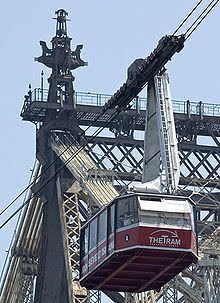 The newly rebuilt Roosevelt Island Tramway opened today, following a nine-month modernization project which replaced the previous 33-year-old tram system. The new tram reduces travel time, permits both cabins to start on the side with highest demand during rush hour, and includes new safety measures, according to an announcement by the Roosevelt Island Operating Corporation (RIOC), a New York State Public Benefit Corporation in charge of the management of Roosevelt Island.
The newly rebuilt Roosevelt Island Tramway opened today, following a nine-month modernization project which replaced the previous 33-year-old tram system. The new tram reduces travel time, permits both cabins to start on the side with highest demand during rush hour, and includes new safety measures, according to an announcement by the Roosevelt Island Operating Corporation (RIOC), a New York State Public Benefit Corporation in charge of the management of Roosevelt Island.
“Roosevelt Island’s Tramway is once again the most modern urban aerial transportation system in the world,” said Leslie Torres, President of RIOC, at the ribbon-cutting ceremony for the new tram. “It’s built to serve residents, business, and tourists for the next thirty (30) years.” Roosevelt Island is currently home to approximately 12,000 residents, open spaces, recreation areas, six landmarks, schools, and shops. The Tram continues to be part of the Metro Card fare system, providing free transfers to buses and subways. The infrastructure improvement was funded through a $15 million investment from the State of New York and $10 million from RIOC.
The Tram was designed to be more stable in high winds, eliminate impact of electrical and mechanical malfunctions, and allow for one cabin to continue operations while the other undergoes preventive maintenance. According to Brian Lawler, Commissioner and CEO of New York State Homes and Community Renewal, “We created this tram with the convenience and safety of Roosevelt Island residents, businesses and tourist in mind. A state-of-the-art tram helps further our mission to create a model community of mixed-income housing, small businesses and plenty of open, green space to serve both island residents and the larger City community.”
Key innovations for the new Tram include:
• Two separate Tram systems. Each cable track operates independently of the other, allowing for preventive maintenance and other servicing on one side, while maintaining service on the other.
• Cabins that are attached to a double hanger arms, providing for a more stable ride. The cabins of the previous system were suspended from a single hanger arm.
• Built-in operational and electrical back-ups including a separate motor for each cabin, back-up motors for the cabins, and four (4) back-up generators.
Pomagalski, S.A. (Poma), one of two companies world-wide capable of rebuilding the tram, was awarded the design/build contract in 2008, after a selection process. POMA worked closely with local trades and contractors, under the supervision of RIOC and its engineering team consisting of New York based LiRo Engineering and Thornton Tomasetti, and Shea, Carr, Jewel of Denver, Colorado. Leitner-Poma, the American affiliate has a five-year operating agreement to run the Tram with a New York based crew.
The Roosevelt Island Operating Corporation of the State of New York was created by State statute in 1984 with responsibility for the operation and development of Roosevelt Island. A General Development Plan, which accompanied the 1969 Ground Lease between New York City and State, directed the development of “a new community” specifically providing for mixed income housing, an abundance of open space, protection of its six City landmarked buildings, protection of the environment and innovative solutions to New York’s technology requirements. “.. a demonstration of modern planners’ capacity to harness technology for human use, while enhancing rather than degrading the environment.…”, according to a 1976 editorial marking the naming of Roosevelt Island after our 32 President.
The Roosevelt Island Plan is now nearly complete. The Four Freedoms Park, a memorial to President Franklin D. Roosevelt, is under construction and three more residential buildings are expected within the next few years. The Tram’s redesign anticipates increased usage over the coming years.